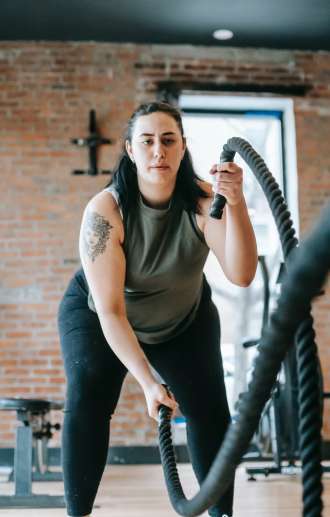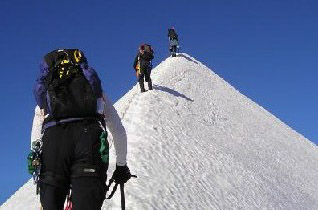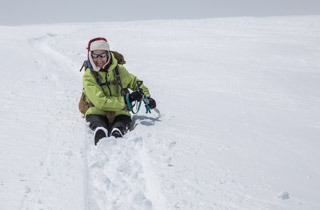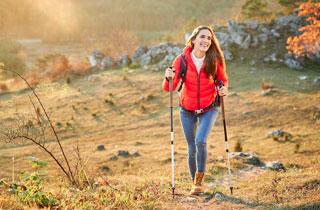Adding Resistance to Your Workouts
Adding Resistance to Your Workouts
Exploring Resistance Training
Including resistance training in your workout program adds all sorts of benefits from increased bone density, a boost to your metabolism, more muscle definition, and best of all, ease in doing everyday tasks. Plenty of strength exercises require nothing more than your own body as resistance. However, for some exercises, body weight can be too much (i.e. pull-ups, particularly for women) or not enough (i.e. squats).
Whenever possible, we recommend training with free weights rather than machines to integrate the working muscles as a whole, and to prepare the body for the three-dimensional challenges of your sport. When you work with free weights, you must balance the weight in all dimensions. Such training loads the spine just as you would on a trail, playing field, slope, or rock wall, rather than moving an attached object while you are supported sitting, leaning, or lying down.
If you want to add resistance training to your program, explore the following options to find what works best for you.


Free Weights Options without Free Weights
“Free weights” training can be done at home, at a gym, or outside, using objects you might commonly use for gardening or household chores, or standard dumbbells and barbells. You can get a great workout at home without a lot of equipment, with some imagination and creativity.
- Load a backpack for resistance for upper and lower body strength training.
- Load books in a sturdy container for deadlifts.
- Use gallon jugs of water for any arm exercises requiring up to seven pounds of weight, or load jugs with gravel or sand for more resistance.
- Use dictionaries as low steps or to train grip strength.
- Use stair steps or sturdy crates instead of a store-bought tiered step.
- Build a step using cement or concrete blocks under a thick sturdy board to work the legs.
- Use the edge of a heavy chair, couch, or bathtub for triceps dips.
- Hang a pull-up bar in your doorway and do a few hangs or chin-ups every time you walk underneath it.
- Use a wheelbarrow filled with dirt, sand, or other materials for grip and arm strength.
- Do household chores and yard work while wearing a weight vest if you like.
Physical activities requiring carrying, bending, lifting, and moving objects are especially useful for developing the kind of strength you can use when digging a snow cave, carrying a heavy backpack, or helping to pull someone out of a crevasse. This sort of training can be very cost-effective but does require a little more thought and creativity initially, and it might be more challenging to determine what weight you are using unless you have a good scale handy.
Band and TRX Training
Another option for increasing strength is using band resistance. Surgical tubing, bungee cords, resistance bands, elastics, or bicycle inner tubes of all sizes, shapes, resistances, and colors, with or without handles, can be used for modest strength gains. They are lightweight and compact for easy storage and transport. However, bands differ from free weights in that the resistance supplied is greatest at the fully contracted portion of the exercise and may be almost zero at the starting position.
Weights such as dumbbells or barbells, on the other hand, will feel the same at the bottom as they do at the top, as their mass does not change throughout the movement. Bands offer benefits in rehabilitation if you need to work through a partial range of motion. For someone brand new to resistance training, even the lightest bands may be sufficient for several weeks.
TRX Bands
Flexible ladder straps made popular by TRX are another versatile option that allows bodyweight resistance in more positions including leaning, one- or two-limbed movements, supported and horizontal. They do, however, need a secure place to attach for full benefits. These are good for exposed garage rafters, for example, low tree branches outdoors, squat racks, or sturdy door jambs.
Household Chores
You can build strength using anything that provides you with an adequate amount of resistance. Lifting your dog into the bathtub or playing tug-of-war can provide work for the biceps, lats, legs, and core. Hours of yard work from raking to loading wood, digging dirt to plant trees, or shoveling snow targets the obliques, lower back, arms, and shoulders. Carrying groceries home from the store in a backpack or books to and from the local library develops strength and endurance in all the muscles needed for backpacking.
Try filling a large duffel bag with sand and carrying or wrestling with it for increasing time intervals (a form of “dinosaur training”). This requires no traditional gym equipment but provides full-body benefits. The more active you can be at working against gravity while weight-bearing (including lifting and carrying a child, whether in front or behind you) the stronger you will become. Even putting on music and upping the tempo of your scrubbing, mopping, or sweeping — with a light pack or ankle weights — can be considered a light form of resistance training. Get creative!

Limb Loading: Ankle Weights
Clients often ask about adding ankle weights to hikes. The best way to prepare your hip flexors for snowshoes, crampons, or heavy mountain boots is to use the boots you will be using on your outings. Adding ankle weights might alter your gait in a way that could be harmful. However, adding ankle weights to your backpack as additional weight, or occasionally strapping them to your wrists to work biceps, shoulders, or triceps as you walk are both decent options.
If you feel you must add resistance to prepare for snowshoeing or mountaineering, avoid going any heavier than the heaviest weight you would need (i.e. 1-2 pounds). Ankle weights can be great for hand, wrist, or elbow rehabilitation, as you can strap them to your wrists without having to grip them.
Summing Up
Consider trying all kinds of resistance to see what you most enjoy. Exercises including pushups, pullups, triceps dips, lunges, squats, dips, handstands, almost all yoga poses, a large variety of abdominal work, and variations on each exercise just listed are all possible using your bodyweight as resistance. As your strength increases, add difficulty by using a weight vest or backpack. Happy lifting!






